1. Canned Beef Stew
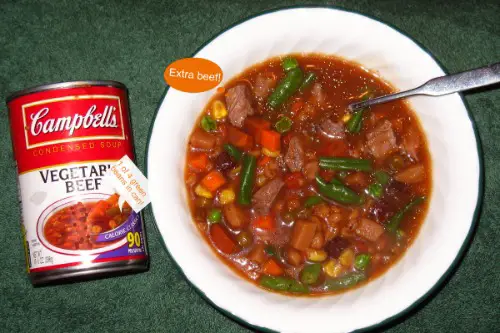
Beef stew in a can was a quick meal for many busy families during the 1950s, The Family Dinner Project blog shares. Brands like Hormel’s “Chunky” line made it a household name, offering a comforting, hearty meal that was both filling and easy to prepare. The promise of tender beef, vegetables, and a flavorful broth in one easy-to-open can was undeniably appealing. After a long day, all you had to do was heat it up and dinner was ready in minutes. For the time, it was a revolutionary convenience.
However, as tastes shifted over the years, canned beef stew fell out of favor. People started to appreciate fresher, more flavorful versions of stew made with quality ingredients. Additionally, the canned versions often contained high levels of sodium and preservatives, which became a turn-off for health-conscious consumers. As homemade recipes became more accessible, canned beef stew became an outdated option in a world that was moving toward better, more wholesome meals.
2. Canned Ham

During the 1950s, canned ham was a go-to for many American families looking for a quick, easy protein. With brands like Hormel and Libby’s leading the way, the canned ham offered a convenience that sliced deli meats or fresh ham couldn’t match. The appeal was simple: you could open a can, slice it, and serve it without the need for cooking or preparation. It was often paired with holiday meals or served in sandwiches, and it had the added benefit of a long shelf life, which made it perfect for pantry stocking.
These days, canned ham is largely absent from grocery store shelves. While it was once considered a hearty option, it has fallen out of favor due to changes in consumer preferences for fresher, less processed meats. Modern shoppers now prefer premium cuts of fresh ham or more artisanal cured meats, and they tend to avoid canned options, which are often high in sodium and preservatives. As people became more health-conscious and aware of the quality of the meat they consume, canned ham became an outdated, unappealing choice.
3. Canned Spaghetti and Meatballs
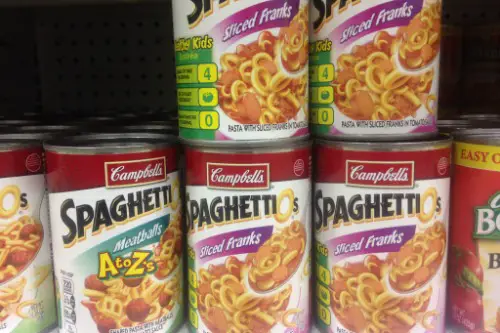
Back in the 1950s, convenience was king, and canned spaghetti and meatballs offered busy families a quick and filling dinner solution. Brands like Chef Boyardee were at the forefront of this trend. The cans promised a home-cooked meal in mere minutes, which was perfect for the fast-paced post-WWII lifestyle. Plus, the combination of pasta, sauce, and meatballs was a hearty, comforting option that many enjoyed. In fact, the product was marketed as a way to “feed your family in a flash,” which resonated with homemakers who valued efficiency.
However, over time, people began to prefer fresher, homemade versions of spaghetti and meatballs. As culinary tastes evolved and the interest in health-conscious eating grew, the canned version seemed too processed, overly salty, and lacking in the flavor depth of a freshly prepared dish. The rise of frozen meals and better alternatives for quick dinners made canned spaghetti a relic of the past. Nowadays, you’d be hard-pressed to find many people opting for a can of spaghetti when they can easily whip up a more satisfying version from scratch.
4. Canned Green Beans with Bacon
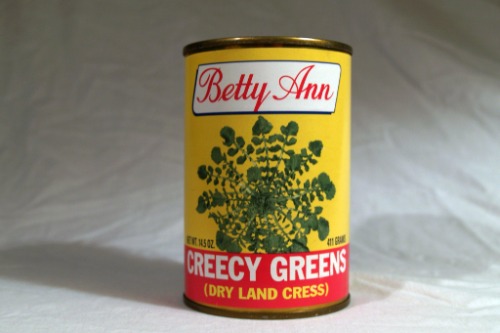
Canned vegetables were extremely popular in the 1950s, with canned green beans being a staple side dish in many American households, according to AllRecipes. The canned green beans with bacon were especially popular for holidays and family gatherings. The bacon added a savory kick, which paired nicely with the sometimes bland nature of canned vegetables. In an era before fresh produce was available year-round or as easily accessible, the canned variety provided a dependable, long-lasting option. People would grab a can, heat it up, and have a side dish in no time.
As the years went by, however, canned vegetables began to lose their appeal. Advances in refrigeration and the expansion of grocery store offerings meant that fresh vegetables were now more accessible, even in winter. Also, modern taste buds have shifted toward enjoying vegetables in their natural form, free from excessive preservatives or salty additives. In today’s health-conscious world, canned green beans with bacon often seem too greasy and unhealthy, making this once-popular side dish a thing of the past.
5. Canned Cheese
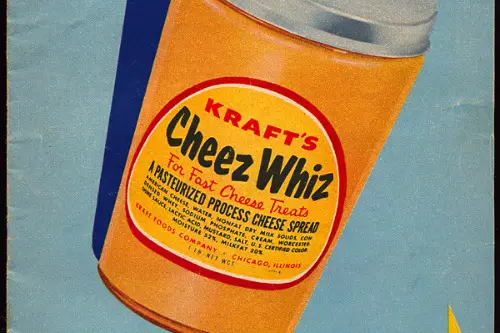
In the 1950s, canned cheese products like Cheez Whiz were a hit with consumers, especially working class, according to TASTE. The convenience of being able to squeeze out cheese for snacks, sandwiches, or even as a dip for vegetables was revolutionary. It promised the gooey, cheesy goodness without the need for refrigeration, making it a great option for both home kitchens and camping trips. It was also marketed as a time-saver for busy families, allowing them to prepare cheesy dishes with minimal effort.
Fast forward to today, and canned cheese has become a product most people avoid. With the rise of more natural and artisanal cheeses, the overly processed, synthetic taste of canned cheese is no longer desirable. The texture and flavor have been described as artificial, and many people now prefer to spread fresh cheese on their crackers or use it in cooking. While the nostalgia for Cheez Whiz may linger for some, it’s not something that fits into today’s more health-conscious food trends, where people seek real, unprocessed ingredients.
6. Canned Spam

Spam, a canned meat product made primarily of pork, became a symbol of wartime necessity and convenience during the 1950s. It was a shelf-stable product that could last for months, providing families with a quick protein source. Spam was often fried up for breakfast or used in sandwiches and casseroles. Its popularity was largely driven by its low cost, long shelf life, and ability to withstand storage in a time when refrigeration was less widespread.
In recent decades, however, Spam’s appeal has waned significantly. While it still has a dedicated following in certain regions (like Hawaii, where it remains beloved), the rest of the country has mostly moved on. The overly processed nature of Spam, along with its high sodium content and questionable ingredients, has led to its decline. As people have become more aware of nutrition and food quality, canned Spam has become a less desirable option, especially when fresh, healthier alternatives are now so widely available.
7. Canned Fruit Cocktail

Canned fruit cocktail was a common sight on family dinner tables in the 1950s, often served as a side dish or dessert. The mix of syrup-soaked fruit like peaches, pears, and cherries was seen as an easy way to incorporate fruit into a meal without worrying about spoilage or preparation. It was marketed as a wholesome, convenient option that could be enjoyed year-round, regardless of season.
However, with the rise of fresh fruit availability and growing concerns about the health risks of high-sugar canned goods, the fruit cocktail’s time has passed. The syrup it came in was often loaded with sugar, making it an unhealthy option for many people today. Additionally, many find the texture of canned fruit to be less appealing than fresh fruit, which has led to the near disappearance of fruit cocktail from modern grocery lists.
8. Canned Corned Beef

Canned corned beef was a popular, budget-friendly option during the 1950s, especially in immigrant communities. Its salty, fatty, and savory flavor made it an easy addition to a variety of dishes, from hash to sandwiches. It was also marketed as a hearty protein that could be kept in the pantry for a long time, making it a convenient choice for families. Canned corned beef found its way into many homes, particularly because of its long shelf life and versatility.
These days, corned beef has mostly vanished from the American diet, particularly the canned version. People now prefer fresher, more flavorful cuts of meat, and the heavily salted, processed nature of canned corned beef has caused many to move away from it. In addition, canned meats have a stigma of being overly fatty and lacking in quality compared to freshly prepared dishes, which has contributed to the decline of canned corned beef as a mainstream food.
9. Canned Deviled Ham
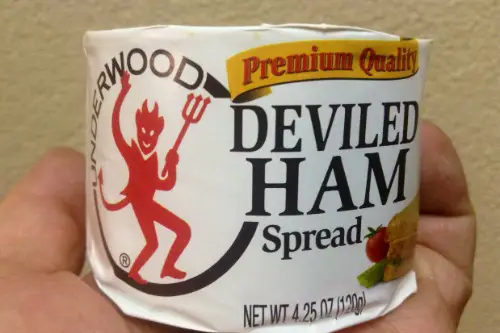
Canned deviled ham was a quintessential 1950s snack, often spread on crackers or used in sandwiches. The product, typically made by brands like Underwood, offered a spicy, savory filling that was easy to prepare and store. Deviled ham was marketed as an affordable and quick meal option for busy homemakers, with its strong, tangy flavor standing out in a sea of milder food options. It was often a treat for lunch or served at parties as a dip or spread.
However, the novelty of canned deviled ham wore off as tastes evolved. The overly processed nature of the product, coupled with concerns about sodium levels and preservatives, made it less appealing to health-conscious consumers. As fresh, more flavorful spreads gained popularity, canned deviled ham slowly faded into obscurity. Its texture and taste are often described as too artificial and greasy, making it an outdated option that few people are excited to eat today.
10. Canned Peas
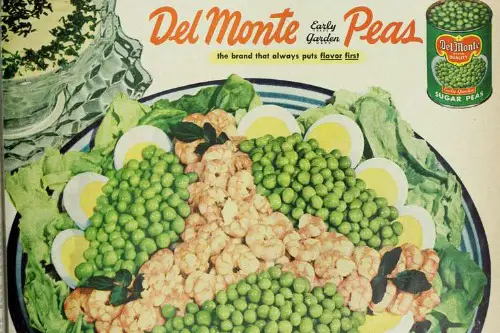
Canned peas were a common side dish in the 1950s, often served as part of a balanced family dinner. They were prized for their convenience, as they required little preparation and had a long shelf life. The peas would come pre-cooked in a can, so all that was needed was a quick heat-up. During the time, fresh vegetables weren’t as accessible as they are today, making canned options like peas a staple in many pantries.
Today, however, canned peas have lost much of their popularity. The taste and texture of canned peas are often described as mushy, and many people prefer the flavor and crunch of fresh peas or even frozen peas, which better preserve the vegetable’s natural flavor. With the growing demand for farm-to-table and organic produce, canned peas have become an outdated choice for vegetable lovers looking for something fresher and less processed.
11. Canned Chicken a la King

Canned Chicken a la King was a quick and easy meal solution for families in the 1950s. The dish, typically consisting of chicken, vegetables, and a creamy sauce, was marketed as a comforting and elegant meal that could be prepared with minimal effort. All you needed was a can of Chicken a la King and a stovetop to heat it up. It was popular because it provided a filling meal with meat and veggies in one convenient package.
However, as people’s tastes changed and culinary sophistication grew, canned Chicken a la King became less desirable. The flavor and texture of the canned version were often considered bland and unappealing, especially compared to freshly made versions of the dish. Today, most people would rather prepare Chicken a la King from scratch or purchase a freshly made version from a deli, leaving the canned variety behind.
12. Canned Mixed Vegetables

Canned mixed vegetables were a common pantry staple in the 1950s, offering a convenient way to get a variety of vegetables without the hassle of chopping or cooking. The mix often included carrots, peas, corn, and sometimes potatoes, all in a single can. The appeal of canned mixed vegetables was their versatility—they could be tossed into stews, soups, or served as a side dish with minimal preparation.
As the years passed, however, people began to prefer fresh vegetables, which offered better flavor, texture, and nutritional value. The canned version often contained too much salt and preservatives, which led to a growing preference for more natural options. Nowadays, canned mixed vegetables are far less popular, especially with the rise of fresh produce and the easy availability of frozen vegetables that retain their taste and nutrition better.
13. Canned Tuna Noodle Casserole
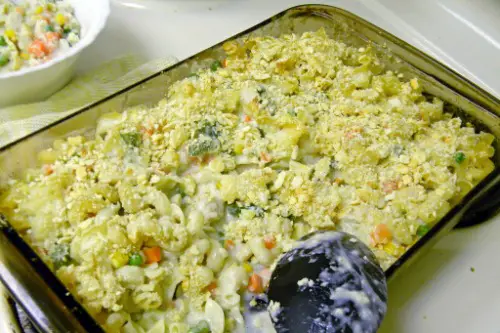
Canned tuna noodle casserole was a beloved comfort food in the 1950s, a dish made with canned tuna, noodles, cream of mushroom soup, and a variety of seasonings. It was an easy and economical dinner option for families, especially when times were tough. The combination of creamy soup and tuna made for a satisfying meal, and the addition of breadcrumbs or cheese on top gave it an extra layer of texture and flavor. The dish was marketed as an affordable, filling way to feed a large family.
Today, however, canned tuna noodle casserole has fallen out of favor. Many people now prefer fresher, more flavorful ingredients, and the idea of using canned soup as a base for a casserole is less appealing. There are also growing concerns about the environmental impact of canned tuna production, leading many to avoid it altogether. While casserole dishes are still popular, people tend to make them with fresh ingredients, leaving the canned tuna version as a relic from a past era.
14. Canned Mushroom Soup
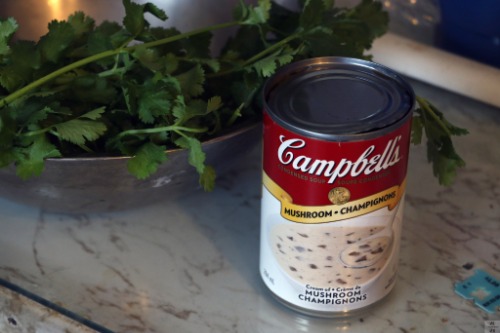
Canned mushroom soup, particularly the famous Campbell’s variety, was a pantry essential during the 1950s. It was not just a soup but a key ingredient in countless casseroles, sauces, and comfort foods. The smooth, creamy texture and rich, earthy flavor of the soup made it a versatile and easy choice for homemakers. It also served as a shortcut to making more elaborate dishes, saving time in the kitchen.
However, as the years went on, canned mushroom soup became less popular. People started making their own soups from scratch, using fresh mushrooms and ingredients that didn’t include artificial preservatives or excessive sodium. Canned soups also became associated with overly processed foods, which many people now avoid in favor of healthier, fresher options. Canned mushroom soup, once a kitchen staple, has largely faded from modern meal planning.


